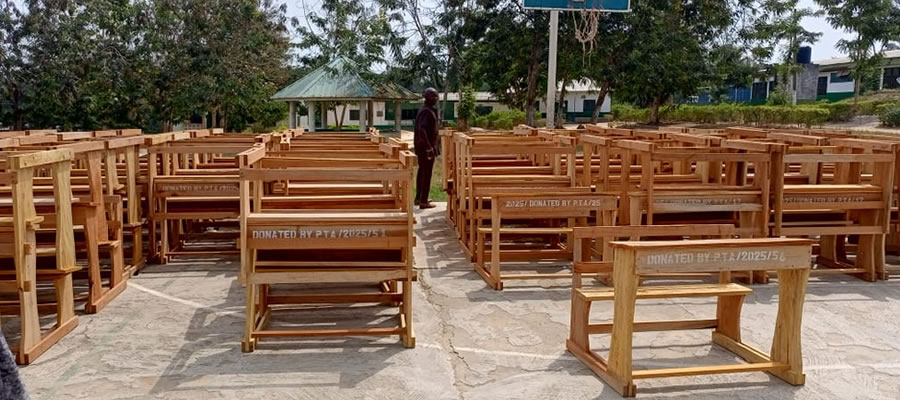

POPULATION SIZE AND GROWTH
The District Population currently stands at about 128,604. This is a projection of 2.9% growth rate on the 2010 PHC figure of 104,244. This representing 4.7% of the total population of the Central Region of 2,201,863. This is made up of 50,936 males and 53,308 females, the entire District population is however RURAL.
SPATIAL DISTRIBUTION OF POPULATION
A survey conducted by the DPCU of the D.A in 2016 indicates there are about 174 settlements and communities, spread across the District. The major settlements are linear along the road network of the District. Most of the bigger settlements are located along the main Cape Coast- Kumasi High Way. However, there are many clotted hamlets in the farming areas. The scattered nature of these hamlets poses serious planning challenges
POPULATION DENSITY
The 2010 PHC puts the population density at 87 persons per square kilometres. This figure is quite lower than the region’s average of 162 persons per square kilometres. As indicated earlier, this figure does not make the District a good candidate for higher order services.
HOUSEHOLD SIZES / CHARACTERISTICS
The 2000 PHC estimated the Household size of Assin South District to be 4.9 persons this figure reduced to 4.4 persons per household (PHC, 2010). This figure is the same as the national average of 4.4, and it is still high. In fact the high population growth rate of 2.9% has the tendency of worsening the housing situation if adequate measures are not put in place to address the above trend. Indeed, large household sizes could unpeel serious economic and social hardship on household heads unless income levels improve.
AGE-SEX COMPOSITION
According to the 2010 PHC the sex ratio is 1:0.956. In other words, for every 100 females there are 95.6 males. The above has serious implications for fertility, migration, dropout rate, unemployment, vulnerability, poverty levels, HIV/AIDS related issues etc. According to 2010 PHC also, the present population structure depicts the normal trend of a large population of below 15 years. They constitute about 43% of the total population which is higher than the region’s average of 24%, while the remaining 57.4% is made up of adults above 15 years. Specifically, the less than 5 years and 5-9 years constitute 15.4% and 14.2% of the population respectively.
Fig 3: Population Structure
Source: 2010 Population and Housing Census
The youthful population might be due to:
1. High child survival rate of 83.5% (meaning mortality rate is low at 17.5%).
2. High fertility rate of 4.31% as compared to that of Cape Coast 2.21 and the region’s average of 3.6%. 3. Low family planning acceptance rate of 5.6%.
This trend requires the District Assembly to make provision to take care of future demands and pressures on social services. Indeed, the old age (60 years & above) figure of 6.4%, though an improvement over the 2000 figure of 4.8%, is slightly higher than the national figure of 4.7 but lower than the regional figure of 7.4. This is still indicative of low life expectancy and hence high incidence of poverty. This situation calls for wealth creation by initiating wealth creation measures.
There is also the need to institute old age programmes such as social security pension schemes and welfare programmes. Again, integrating decent work programmes into employment policies could help address some of the problems associated with old age, especially for those in the informal sector.
DEPENDENCY RATIO
The statistics on the age distribution puts the dependency ratio at 93.4, which is higher than the region’s average of 89.4. This means that one worker within the labour force has more than a person to cater for. This is characteristics of developing countries. This again, has serious implications for savings, investment, poverty reduction, growth and standard of living.
LABOUR FORCE AND DEPENDENCY RATIO
The District has a comparatively high labour force of 51.7%. This is made up of the population between the ages 18 and 60 years. The dependency ratio on the other hand constitutes the ages below 18 years and above 60 years. Although the District has a large labour force, only a small proportion is gainfully employed. Unemployment figure is therefore high depending on the location of communities. Unemployment is higher in the semi-urban and commercial centres, the rural non-commercial centres.
POPULATION PROJECTION
The population of the District is projected to stand at 139,616 by 2021 using a growth rate of 2.9%. The table and diagramme below illustrates the projected population growth of the District.
Fig 4: Population growth
The District’s population growth rate of 3.4 is lower higher than the regional and national figures of 3.1 p.a and 2.5 p.a respectively. This has serious implication for development planning.
IMPLICATIONS ON EDUCATION
It indicates that within the next year or so, the population of students in the various educational institutions is likely to overburden the facilities and these will need further expansion to absorb the increase. This is so because, given the current state of educational facilities and trained teachers as well which cannot be said to be adequate is likely to worsen if the facilities are not upgraded or increased.
IMPLICATIONS ON HEALTH
The District is already heavily overburdened when it comes to the provision of health facilities. With the current population projections, it implies that the inadequate facilities will be excessively overburdened; this could lead to poor health service delivery resulting to increased mortality within the District.
IMPLICATIONS ON SANITATION
It is evident what increase in populations is capable of when it comes to environmental sanitation issues. With the current population projection which is by all means high, it is expected that there will be some sanitation concerns with regard to waste management and environmental degradation. The current number of institutional KVIP latrines will be overburdened leading to defecation at open places. A lot more waste will be generated and its management will be very important.
IMPLICATIONS ON ECONOMIC ACTIVITIES
Just as the projections indicate increasing increase in population growth, it also indicates there might be an increase in the level of economic activities going on within the District. This will eventually help improve the District economy and increase the revenue base of the District Assembly, in this regard, the markets and trading centers should be expanded and improved to take advantage of this situation.
RURAL-URBAN SPLIT
The District is typically rural in nature. In fact, there is no settlement in Assin South with a population more than 5,000 residents as at the 2010 PHC. By the definition of town, as a location having a population 5,000 people, one can say that, there are no towns in Assin South District going by the 2010 PHC figures.
Nsuaem-Kyekyewere, the District Capital, had a population of 3,621 and therefore by our definition cannot be regarded as a town. With the population growth rate of 2.9% pa, Assin Andoe, Adiembra, Nsuta, Ayinabrem and Nyankumasi which are likely to attain the 6,000 person margin by 2020. However, using the intensity of political, commercial and administrative activities to define a town, one can identify Nyankomasi-Ahenkro, Assin Manso, Assin Andoe, Assin Anyinabrim and Assin Nsuta as some of the towns in the District.
The above has greatly affected the provision of basic and higher order services, which require population threshold or density such as the requirements for Small-Town Water Systems or Hospital or Markets.
Fig 5: Rural / Urban Split
MIGRATION
As at the 2010 PHC, the District had a migrant population of over 32,580. 64.9% of the migrant population which is the majority, were elsewere in the region while 33.7% were born in other regions. About 32% of the total population of the Assin South District are migrants. They are made of Ewes (9.8%), Ga-Dangme (5.6%), Guans (3.0) and others (1.6%).
GENDER
The gender situation in the District is no different from other parts of the region, females are those responsible for the keeping of households whilst males are responsible for the provision of day to day income for the running of the households. Households are headed by men when it is a household made up of man, woman and children or even with extended families included.
Nevertheless, households are mainly run by woman in situations where a household comprises of the man, woman and children and including external relations. Men provide for such households whilst women are in charge of the household chores including cooking, cleaning, catering for the children, etc.
Women are allowed to acquire and own land or even inherit land or other properties just as men are allowed to. It is important to state that even if a married couple move into a residence which is owned by the woman, the man still takes charge and makes all the decisions for the entire household regardless of the ownership.
Female children mostly help mothers in the delivery of daily chores and may even assume the position of running the household in the absence of the mother or the woman of the house. Female children will mostly also help their mothers in their trading activities or on their farms.
Male children are mostly attached to men of the house and support their fathers in their trade and professions in their quest to provide for the household. This is the case especially when the father is involved in farming or trading and not the formal sector of employment.
Men are the major players in decision making leaving little room for women to contribute. However, this trend is changing as more women are being brought forward when it comes to decision making. Access to social facilities such as schools, hospitals, toilets, etc are liberal as both sexes can use them freely.
More women are engaged in petty trading, hawking and a little farming, whilst the men are engaged in large scale farming, industry and heavy constructions.
Other social facilities such as schools, health centres, recreational grounds and markets are all accessible to both sexes and both genders.
Women play dominant roles in societal development in economic, political and social fronts, their economic empowerment and social improvement in their income levels have had positive multiple effects within households, particularly on children.
There have been challenges in women taking up leadership roles in the communities, out of a total of 22 elected Assembly members, none of them is female. This situation arises due to the lack of courage and timidity on the part of women to contest and even hold positions of power and authority in the District.
Culturally, men and women are inhibited form taking joint decisions at the household family and community level. This call for culturally sensitive approaches to planning and management of development programmes. Such an approach will help educate both men and women in health, education, and also obnoxious cultural practices like Female |Genital Mutilation (FGM), early marriages, development and widowhood rites and inheritance. This will also promote mutual respect between the male and female as partners in development of members of the human role who deserve equal human, legal and political rights.
SPATIAL ANALYSIS OF SETTLEMENT SYSTEMS
The District has a total of 140 Communities and over 230 settles spread across the District landscape of 1,187 square kilometres. The major uses of land in the District are farming and construction and the settlement systems are scattered all over the various parts of the District.
There are a lot of facilities such as schools of all levels (K.G, Primary, Junior High and senior High Schools), health centres, market centres, different kinds of water systems and so on. However, access to all the facilities by all the settlements and communities is not even. This is to say that, some communities have more ease in the access of some facilitates than other communities.
This is largely due to the location of the facility and the threshold population its supposed to serve and yet the access routes i.e the roads and means of transportation are not readily available.
A scalogram presentation of the distribution of 32 essential services in the 20 largest Communities in the District is presented below. A scalogram is a matrix presentation of functional structure of settlements. The service facilities used for this analysis are: K.G, PRIMARY, J.H.S, S.H.S, CHPS ZONES, CLINIC/ Health, HOSPITAL, Maternity HOMES, TBAs, HAND DUG-WELL, BORE HOLES, Small Town Water System, KVIP, House Hold WC, Circuit COURT, Police Station, FIRE STATION, NTERNET, TELEPHONE, POST OFFICE, HOTELS, GUEST HOUSE, LORRY PARK, FUEL POINT, Agric Extension, Market Centre, PRIM. ROAD, FEEDER, DRUG STORE, ELECTRICITY, COCOA SHED, Community CENTRE
Table 6: Scalogram Analysis
In all, 20 Communities with population above 1,000 were examined. The total number of services considered was 32. The scalogram shows that none of the settlements have all the services considered. Nyankomasi-Ahenkro is the only settlement found to be at level 1, having 27 services out of the 32 considered.
Assin Manso came out as level 2 with 24 services. Asamankese/Achiase, Anyinabrim, Ongwa and Darmang having 22 and 21 respective services also came out as level 3 but higher order.
Andoe, Adiembra, Nsuta and Nsuaem/ Kyekyewere came out as level 4 with 20 facilities whilst Jakai, Ngresi, Akrofuom, Adubiase, Bosomadwe, Kruwa and Ochisu as level 5 with facilities ranging between 19 and 16 facilities. Level 6 settlement, with only 14 and 13 facilities are Aboabo Camp Amoaben and Nyamebekyere.
Most of the settlements with high level of facilities are the ones along the Cape Coast – Kumasi High way. This indicates that distributions of facilities are skewed towards the settlements along the main road which also happens to have higher populations.
A critical look at the scalogram also shows that certain key facilities such as, hospitals, fire stations, police stations in the District capital and Lorry parks in the District Capital are lacking in the District. This analysis therefore suggests that the DA should make it a priority to provide these facilities.
Date Created : 10/7/2024 2:40:35 AM











 facebook
facebook
 twitter
twitter
 Youtube
Youtube
 +233 593 831 280
+233 593 831 280 0800 430 430
0800 430 430 GPS: GE-231-4383
GPS: GE-231-4383 info@ghanadistricts.com
info@ghanadistricts.com Box GP1044, Accra, Ghana
Box GP1044, Accra, Ghana